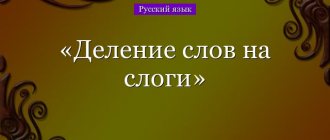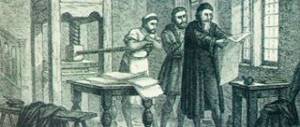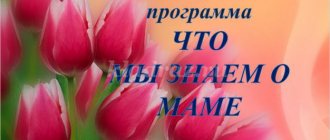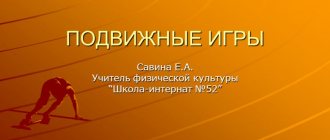Introduction
At the beginning of my research work on the elementary school “The Letter E in the Russian Language,” we will define the subject of research, the goals and objectives of the work, identify the problem and put forward a hypothesis.
Subject of study: letter E.
Purpose: to explore the history of the origin of the letter E and determine its significance.
Objectives: - collect material about the history of the origin of the letter E; - find out the significance of the letter E; — conduct a survey among teachers and students.
Problem: the “youngest” letter may disappear.
Hypothesis: there are no unnecessary letters in the Russian alphabet. We must use the letter E.
Letter and sound
The letter E has two sounds: [je] (yot + e).
And “E” at the beginning of the 18th century replaced the combination of letters “io”, which had previously been used in its place. Thus, “ё” also makes two sounds: “jo” (jot + o).
Softness index
“E” and “E” are always an indicator of the softness of the preceding consonant. For example:
Place, mirror, pull ([m'e]sto, [z'e]rkalo, [d'o]tear – the letter “E” is an indicator of the softness of the consonant sound “d”, “m”, “z”).
As you can see, the letter E is an indicator of the softness of consonants, because it itself becomes the sound “e” and “o” (if it is the letter “e”), respectively.
There are exceptions in which these letters do not soften the preceding consonant. These exceptions are almost all borrowed words, for example:
- manager ([man]enger),
- annexation (an[ne]xia),
- aggression (ag[re]siya),
- thermal ([te]thermic),
- timbre ([te]mbre),
- express, (exp[re]ss).
Letter E after a vowel
The letters “E” and “E”, like other letters of the double alphabet (yu, ya), denoting two sounds, have a special relationship with other vowel sounds.
When the letter E is written after a vowel, it retains its two sounds [je]:
opening, train - pr[ayo]m, pr[aye]zd.
So the letter “o” sounds like “a”, and the letters “e” and “e” are replaced by [je] and [jo], respectively.
At the beginning of the word
At the beginning of a word, the letters “E” and “E” always mean two sounds, for example:
Hedgehog, ride - [yo]zh, [ye]ride.
In a similar way, these letters are written after hard and soft signs:
Drive away, rise - drive off [ye] drive up [yo]m.
Exceptions in which we do not write the letter “е” at the beginning of the word:
Yogurt, yoga - these two words are written strictly with the combination of letters “yo”.
Justified by the peculiarities of borrowing.
Main part
1.1. Yo is a mysterious and very interesting letter
The letter E is the youngest in the Russian alphabet. It was proposed to be introduced in 1783 by Ekaterina Romanovna Dashkova. But the letter E became famous thanks to Karamzin. In his book, he printed words with the letter “e”: “dawn”, “eagle”, “moth”, “tears”.
Meanwhile, little by little, the letter E began to be fixed in writing.
In Ozhegov’s dictionary, the letter E has its own vocabulary, which contains 12 words: hedgehog, hedgehog, shiver, yokat, fir-tree, herringbone, fir-tree, fidget, ruff, container, brush, capacious.
The slow entry of the letter “е” into life is explained by its inconvenient form for quick writing, which interferes with cursive writing: continuous writing.
Due to the optional use of the letter “ё” in the Russian language, words have appeared that can be written with both the letter “ё” and “e”. and pronounce accordingly. For example: faded and faded, whitish and whitish, maneuver and maneuver, bile and bile.
Having examined the newspapers “Kizilsky Vestnik” and “Guberniya”, I came across only three words with the letter “e”: her, her, everything. And the words “three” instead of three, “bees”, instead of bees, and others were printed without the letter E.
Opponents of the letter E:
- Yo is not a native Russian letter;
- Yo makes it difficult to write text.
Supporters of the letter E:
- Helps convey the diversity and beauty of Russian speech;
- Eliminates misreading;
- Reduces the time of reading and comprehending text.
Firstly, it was invented more than 200 years ago (in the 18th century) by the famous Russian writer N.M. Karamzin, who devoted many years of his life to describing the centuries-old history of the Russian state. In 1797, he first used this letter in the word tears.
Secondly, this letter is special. It is used to denote a stressed sound, which in the same morpheme (root, suffix or ending) in an unstressed position is conveyed by the letter e. Birch - birch tree, carried - carried, black - blackness, etc.
Thirdly, this is the only letter of the Russian alphabet, which was not necessary to use. Now this letter has regained its rights.
The letter “e” became famous thanks to N.M. Karamzin, in connection with which until recently he was considered its author.
In 1796, in the first book of the poetic almanac “Aonids” published by Karamzin, which came out from the same university printing house, the words “dawn”, “eagle”, “moth”, “tears”, as well as the first verb were printed with the letter “e” "drip" Meanwhile, little by little, the letter E began to be fixed in writing.
1.2. Consequences of the optional use of the letter “Ё”
The slow (and never fully realized) entry of the letter “е” into life is explained by its inconvenient form for quick writing, which contradicts the main principle of cursive writing: continuous (without lifting the pen from the paper) style, as well as the technical difficulties of publishing technologies of pre-computer times.
In addition, people with last names with the letter “Y” often have difficulties, sometimes insurmountable, when preparing various documents due to the careless attitude of some responsible employees to the writing of this letter. This problem became especially acute with the introduction of the Unified State Examination system, which manifests itself in the danger of differences in the spelling of the passport name and the name on the Unified State Examination Certificate. The traditional optionality of use led to erroneous readings, which gradually became generally accepted. They affected everything: a huge mass of personal names, and many common nouns.
Due to the optional use of the letter “ё” in the Russian language, words have appeared that can be written with both the letter “ё” and “e”. and pronounce accordingly. For example: faded and faded, whitish and whitish, maneuver and maneuver, bile and bile.
Variants constantly arise in language under the influence of contradictory analogies. For example, the word nadsekshiy has variants of pronunciation with e/e due to the double motivation: notch / notch. The use or non-use of the letter “ё” does not matter here. But with natural development, a literary language always strives to eliminate its variants: or one of them becomes unliterary, incorrect (iz[d'e]vka).
Facts from life: - Perm resident Tatyana Teterkina almost lost her Russian citizenship due to the incorrect spelling of her last name in her passport.
— The Elkin family from Barnaul lost their inheritance due to the fact that it was registered in the Elkins’ name.
— The name of the famous Russian poet Fet Afanasy Afanasyevich was distorted during the printing of his first book. He gained fame under the name Fet.
The letter E sighs and cries, They stole the dots from her. You will no longer see this letter in magazines, books and newspapers. But the letter E is happy. It is found everywhere. Meanwhile, the world cannot live without the letter E! Oh my! Imagine. Under the green Christmas tree, a hedgehog and a quail are shedding tears. Matryona, Peter and Semyon are now left without names. The eagle could not start its flight, the plane interfered with it. On the set, the director and the make-up artist cannot cope with the actor. Having overcome a steep climb, the Donkey fell into a pond. It’s in vain that we wait for honey from the bees. The ferret has come to the apiary. You give the people the letter E! After all, we can’t live without her! And in our Russian alphabet there is such a letter! Please note!
The letter E is the youngest in the Russian alphabet. It was invented in 1783 by Ekaterina Dashkova, an associate of Catherine II, princess and head of the Imperial Russian Academy. At an academic meeting, Ekaterina Romanovna asked Derzhavin, Fonvizin, Knyazhin and others present whether it was legal to write “iolka” and whether it would be wiser to replace the digraph “io” with one letter “e”.
Yo appeared in print for the first time in 1795 in the poems of Ivan Dmitriev, and then, in 1796, in the poems of Nikolai Karamzin. However, the spelling innovation had not only supporters, but also fierce opponents. Minister of Education Alexander Shishkov, for example, leafed through volume after volume of the books he owned, erasing two hated dots from them.
1.3. A Few Colon Facts
— This year Yo turned 233 years old. Her birthday is November 18 (old style) 1783.
— The letter E is in the sacred, “lucky” 7th place in the alphabet.
— There are about 12,500 words in the Russian language with Ё. Of these, about 150 begin with Ё and about 300 end with Ё.
— The frequency of occurrence of E is 1% of the text. That is, for every thousand characters of text there are an average of ten yoshkas.
— In Russian surnames, Yo occurs in approximately two cases out of a hundred.
— There are words in our language with two and even three letters E: “three-star”, “four-bucket”, “Boryolekh” (a river in Yakutia), “Boryogesh” and “Kögelyon” (male names in Altai).
— More than 300 surnames differ only in the presence of E or E. For example, Lezhnev - Lezhnev, Demina - Demina.
— In the Russian language, there are 12 male and 5 female names, the full forms of which contain Y. These are Aksen, Artyom, Nefed, Parmen, Peter, Rorik, Savel, Seliverst, Semyon, Fedor, Yarem; Alena, Klena, Matryona, Thekla, Flena.
— In Ulyanovsk, the hometown of the “yofikator” Nikolai Karamzin, there is a monument to the letter E.
— In Russia, there is an official Union of Efictionists of Russia, which is engaged in the fight for the rights of “de-energized” words.
1.4. Monument to the letter "Y"
A monument was erected in defense of the letter E in the city of Ulyanovsk. They started thinking about installing the monument back in 1997; the idea came from Ulyanovsk historians, who recalled the introduction of this letter into print 200 years ago. The selection of the best design for the monument took place in 2001 at a special city competition.
The opening took place on September 4, 2005, which coincided with the 160th anniversary of the opening of the monument to N.M. Karamzin. He was the first author to use the letter “е”. The winner of the competition, who made the monument, unfortunately, did not have time to receive the red granite he ordered, so the monument had to be made from black, as a result of which it turned out rather gloomy. But despite this, it was still open.
A little later, in November 2005, an updated monument was installed - a triangular pyramid more than two meters high and weighing about three tons.
It should be noted that the monument to the letter in Ulyanovsk is not the only one in the country. Petrozavodsk is famous for its monument to the letter “T”, and Novosibirsk for its monument to the letter “A”, and these are not the only examples.
The role of the letter E in modern Russian language.
Letter "Y"
32 OR 33?
Progress of the study
The object of the study is the letter “ё” as a graphic unit of the Russian language.
The subject of the study is factors influencing the use of the letter “е”.
The purpose of the work is to clarify and evaluate the causes and consequences of native speakers refusing to use the letter “ё”.
Tasks :
1. Study the history of the letter “е”.
2. Find out the rules for using the letter “ё” in the modern Russian language, based on regulatory documents.
3. Find out the attitude of native speakers towards the letter “е”.
4. Observe the use of the letter “е” in personal documents.
5. Draw conclusions about the legality or injustice of abandoning the letter “e”.
6. Find possible ways to preserve the letter “ё” in the Russian language.
History of the letter "е"
The letter “е” was invented in 1783 by Ekaterina Dashkova, an associate of Catherine II, princess and head of the Imperial Russian Academy.
“ё” first appeared in print in 1795.
existed until 1918
On December 24, 1942, by order No. 1825 of the People's Commissar of Education of the RSFSR V.P. Potemkin, the mandatory use of the letter “e” was introduced.
Portrait of Princess E. R . Dashkova.
Stalin I.V.
Standards for using “ё” in modern Russian language
- Modern spelling is regulated primarily by the Rules of Russian Spelling and Punctuation of 1956. According to §10 of these rules, the letter “е” is written in the following cases:
- 1. When it is necessary to prevent incorrect reading and understanding of a word, for example: we recognize in contrast to we recognize; everything is different from everything; bucket as opposed to bucket; perfect (participle) as opposed to perfect (adjective).
- 2.When you need to indicate the pronunciation of a little-known word, for example: Olekma river.
- 3. In special texts: primers, school textbooks of the Russian language, spelling textbooks, etc., as well as in dictionaries to indicate the place of stress and correct pronunciation.
- 4. To prevent incorrect identification of a word, for example: everything, sky, summer, perfect (in contrast to the words everything, sky, summer, perfect), including to indicate the place of stress in the word, for example: bucket, we recognize (unlike a bucket, let's find out).
- 5. To indicate the correct pronunciation of a word - either rare, not well known, or having a common incorrect pronunciation, e.g.: gyozy, surfing, flair, harder, lye, including to indicate the correct stress, e.g.: fable, brought, carried away , convicted, newborn, spy.
- 6. In proper names - surnames, geographical names, for example: Konenkov, Neyolova, Catherine Deneuve, Schrödinger, Dezhnev, Koshelev, Chebyshev, Veshenskaya, Olekma.
Attitude of native speakers to the letter “ё”
Temple of the letter "ё"
in the Chelyabinsk region
Monument to the letter "ё" in Ulyanovsk
- The use of the letter “Y” in personal documents
Carelessly completed birth certificates
- Arguments for and against the use of the letter “Ё”
- Arguments for and against the use of the letter “Ё”
BEHIND
AGAINST
[Yo] is an iotized vowel, and to indicate a sound there must be a letter. It is not logical to mean one letter and write another.
When reading, the brain perceives not just one letter, but a word or even a whole sentence, and it understands which word to choose and how to read it.
Refusal of the letter “ё” is a violation of the Law on the Russian Language.
In writing, writing the letter "е" requires taking your hand off the paper to write dots, which slows down your writing speed and makes it more difficult.
Due to the fact that we do not dot the “e”, we can misunderstand the meaning of the written word, for example: everything or everything, donkey or donkey.
If there is a letter “е” in the surname, and the letter e in the passport, then it is difficult to prove the relationship, take out a loan, etc. For example, Bateneva = Bateneva.
The Russian language is moving towards simplification, and the revival of the letter ё in the Russian language contradicts this process.
Historically, this letter is a borrowed element artificially introduced into the Russian language.
You can make a mistake in pronunciation. For example: beets - beets.
In the 19th century, printing the letter “е” made printing products more expensive.
The absence of the letter “ё” in the texts
makes it difficult for children and foreigners to learn the Russian language.
The letter е decorates the written Russian language, which has so few elements. (opinion of typography specialist V. Krichevsky).
List of references
Sources of information
- Federal Law of June 1, 2005 N 53-FZ “On the State Language of the Russian Federation”
- Decree of the Government of the Russian Federation of November 23, 2006 No. 714 “On the procedure for approving the norms of the modern Russian literary language when used as the state language of the Russian Federation, the rules of Russian spelling and punctuation”
- Letter from the Ministry of Education and Science of the Russian Federation dated July 20. 2009 No. IK-971/03
- Rules of Russian spelling and punctuation. – M., 1956
- Chumakov V. T. Printing e instead of e is a mistake! — M.: “Public Education”, 2005
- Eskova N. About the letter E. // Science and life - 2000. - No. 4
- Artemy Lebedev studio website https://www.artlebedev.ru/kovodstvo/sections/119/
- Wikipedia
- Dictionary of the use of the letter E https://yomaker.narod.ru/yoslovar.htmhttps://yomaker.narod.ru/yoslovar.htm
- The letter e must die! https://nesusvet.narod.ru/txt/yo/
Interesting facts about the letters “E” and “E”
- The letter E is one of the most common letters in our everyday life, although we rarely notice it.
- A white letter E appears on the mobile phone screen when connected to the Internet.
- The letter E depicted on the packages in combination with numbers denotes certain dyes, additives and emulsifiers (popularly known as “eshki”).
- The iron E, which was often seen in the early 2000s, was part of the scrap metal parts.
- The so-called letter “er” has nothing to do with “E”: it appeared in the Russian language much earlier, because it was used as a division between words. It also meant disagreement. It was written as a hard sign - “ъ”.
- According to the Wikipedia page, the letter E has several codes.
Watch a video about the letter E:
And here you can not only download copybooks with the letter E, but also learn how to write it.
Now you know a lot about the letter E and it’s time to learn how to write it correctly in words.







